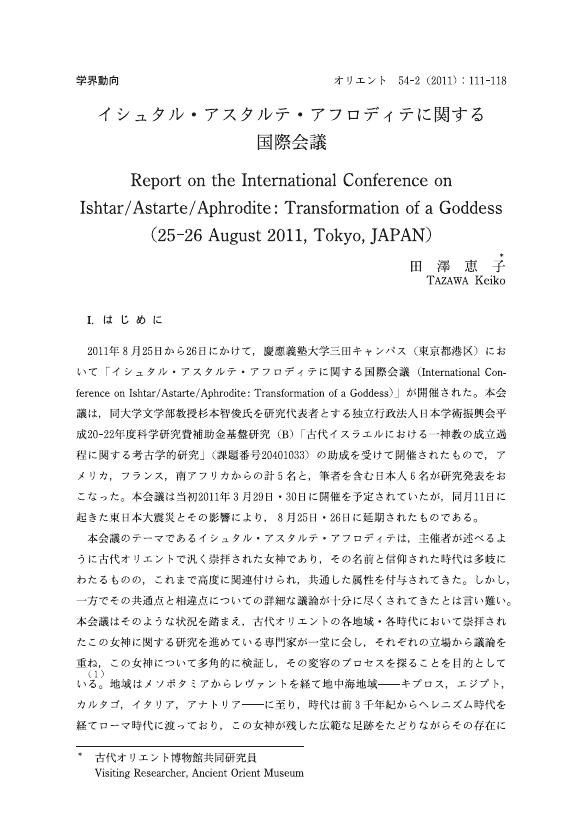11 0 0 0 イシュタル・アスタルテ・アフロディテに関する国際会議
- 著者
- 田澤 恵子
- 出版者
- The Society for Near Eastern Studies in Japan
- 雑誌
- オリエント (ISSN:00305219)
- 巻号頁・発行日
- vol.54, no.2, pp.111-118, 2012
2 0 0 0 古代地中海世界における知の動態と文化的記憶
- 著者
- 周藤 芳幸 金山 弥平 長田 年弘 師尾 晶子 高橋 亮介 田澤 恵子 佐藤 昇 大林 京子 田中 創 藤井 崇 安川 晴基 芳賀 京子 中野 智章
- 出版者
- 名古屋大学
- 雑誌
- 基盤研究(A)
- 巻号頁・発行日
- 2018-04-01
当該年度は、前プロジェクト「古代地中海世界における知の伝達の諸形態」の最終年度に当たっており、そこで既に策定されていた研究計画を着実に進めるとともに、現プロジェクト「古代地中海世界における知の動態と文化的記憶」の本格的な展開に向けて新たな模索を行った。具体的には、図像による知の伝達の諸相を明らかにするために、図像班を中心に研究会「死者を記念する―古代ギリシアの葬礼制度と美術に関する研究」を開催し、陶器画による情報の伝達について多方面からの共同研究を行った。また、9月3日から7日にかけて、国外の大学や研究機関から古代地中海文化研究の最先端で活躍している13名の研究者を招聘し、そこに本共同研究のメンバーのほぼ全員が参加する形で、第4回日欧古代地中海世界コロキアム「古代地中海世界における知の伝達と組織化」を名古屋大学で開催した。このコロキアムでは、古代ギリシアの歴史家の情報源、情報を記録する数字の表記法、文字の使用と記憶との関係、会計記録の宗教上の意義、法知識や公会議記録の伝承のメカニズム、異文化間の知識の伝達を通じた集団アイデンティティの形成、神殿などのモニュメントを通じた植民市と母市との間の伝達など、古代地中海世界で観察される知の動態をめぐる様々な問題が議論されたが、そこからは、新プロジェクトの課題に関して豊富なアイディアと示唆を得ることができた。これについては、その成果の出版計画の中でさらに検討を重ね、今後の研究の展開にあたって参考にする予定である。これに加えて、当該年度には、知の伝承に関する基礎データを獲得するためにエジプトでフィールドワークを行ったほか、9月にはダラム大学名誉教授のピーター・ローズ博士、年度末にはオックスフォード大学のニコラス・パーセル教授の講演会を企画・開催するなど、国際的なネットワークの強化にも努めた。
- 著者
- 田澤 恵子
- 出版者
- The Society for Near Eastern Studies in Japan
- 雑誌
- オリエント (ISSN:00305219)
- 巻号頁・発行日
- vol.52, no.1, pp.63-83, 2009
It is difficult to track down the Levantine origins of the six Syro-Palestinian deities found in New Kingdom Egypt (Baal, Reshef, Hauron, Anat, Astarte, and Qedeshet). Part of the problems is that the images of these deities, venerated both by the royal family and by the ordinary people, were much Egyptianised. It has been pointed out that Syro-Palestinian art was greatly influenced by Egypt, Anatolia and Mesopotamia, which plausibly results in the assumption that Egyptian styles, once exported to Syria-palestine, may have come back to Egypt in the form of 're-imported' images of these deities. This paper will discuss, as a case study, the means by which the representation of the goddess Qedeshet was established.<br> The investigation leads us to the following conslustions: 1) the motif of a naked female <i>en face</i> might have been imported from Egypt to Syria-Palestine before the New Kingdom, but then part of this iconography was possibly brought back to Egypt with the concept of Qedeshet, 2) the idea of the goddess standing on the back of an animal was not Egyptian originally, and as for Qedeshet, the influence of the goddess Ishtar in Mesopotamia would be very important, 3) the snakes in the hands of Qedeshet probably reflect the Egyptian view in which the serpent is the symbol of magical protection, resurrection and vitality in the afterlife.<br> Under the circumstances, it can be deduced that the motif of the goddess Qedeshet in the New Kingdom has not been dominated primarily either by Egypt or by Syria-Palestine but is in fact composed of elements of iconography and concepts from both regions. Some could be originally Egyptian components, introduced into Syria-Palestine earlier and re-imported into Egypt with Syro-Palestinian factors, while others were newly brought into Egypt, and assimilated to some extent with Egyptian ideas on particular aspects.
1 0 0 0 OA イシュタル・アスタルテ・アフロディテに関する国際会議
- 著者
- 田澤 恵子
- 出版者
- 一般社団法人 日本オリエント学会
- 雑誌
- オリエント (ISSN:00305219)
- 巻号頁・発行日
- vol.54, no.2, pp.111-118, 2012-03-31 (Released:2015-04-01)
